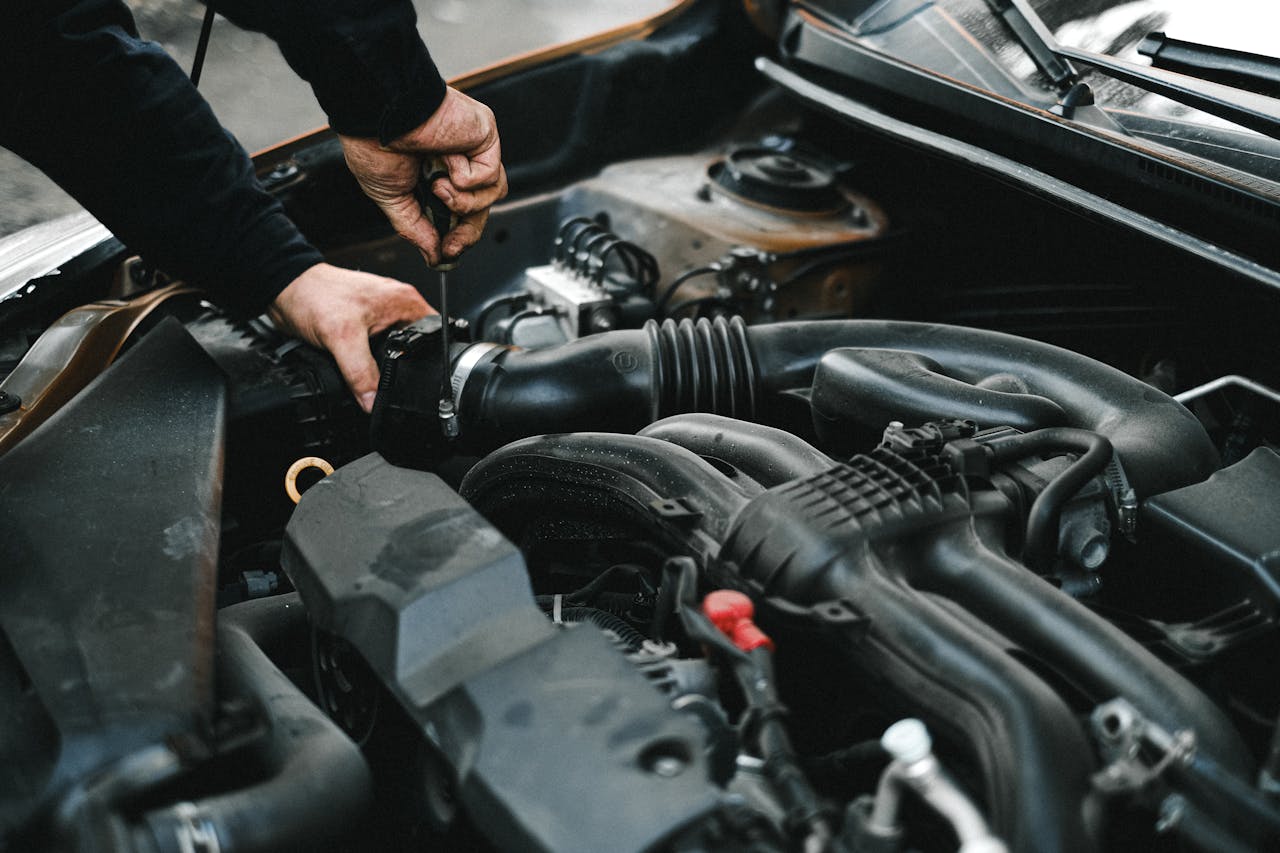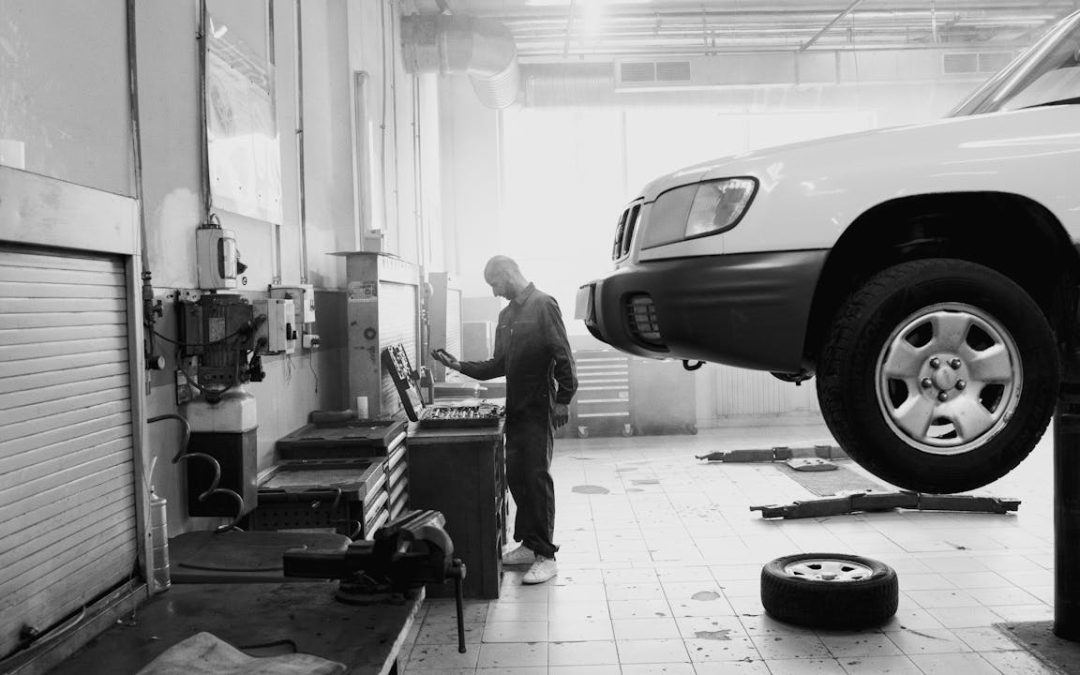Upgrading your radiator fan cuts down emissions by helping your engine keep cool, which means fewer fumes and better results during smog checks.
Now, with a newer, more efficient or powerful fan installed, my engine is always right on that sweet spot. So, it burns a lot cleaner fuel, more stable. This action reduces the likelihood of elevated tailpipe emissions that may cause a smog check failure.
Not only do newer fans use less energy, but they run more quietly. Better efficiency means less fuel burned and a more comfortable ride. For folks in cities like Los Angeles where smog checks are strict, a better fan can help pass on the first try.
Now, I’ll show you how the fan works. I’ll flag what to look out for and outline how to best reap the rewards of this easy upgrade.
Key Takeaways
- Upgrading your radiator fan is one way to ensure that your engine runs at the right temperature. This results in more complete fuel combustion and lower emissions.
- A high-performance fan offers much better cooling for your vehicle. This improvement assists your ride in passing smog checks and adhering to emissions standards.
- Go with a fan that has the latest technology, like variable speed motors. This option allows you to have more control over engine temperature and lowers unnecessary energy consumption.
- Upgrading to a better fan increases the longevity of both your cooling system and your catalytic converter. This will pay off in lower emissions and smog check repair costs.
- Upgraded fans help contribute to optimal engine performance and fuel efficiency, which can translate into improved throttle response and increased MPG.
- As always, before upgrading, make sure it will fit your vehicle. Finally, take a close look at your driving habits and cost/benefit analysis to decide what is best for you.
What Does Your Radiator Fan Do?
Now you understand what your radiator fan does. It can be tempting to ignore any potential problems that arise with the radiator fan. When you start your car and let it idle or drive in slow city traffic, your engine makes heat fast. That’s where your radiator fan comes into play.
The fan turns on to pull air through the radiator, carrying that build-up heat with it. Even on a cool day, engines can overheat fast if they’re not able to move around. When the fan operates properly, it moves air through and over the radiator’s fins, providing optimal cooling.
In turn, this cools the coolant flowing through which helps cool the engine and protects it from overheating. You keep your engine temp where it’s supposed to be. This allows your vehicle to operate at the ideal temperature to burn fuel most efficiently and keep your engine running smoothly.
With a properly functioning radiator fan, you should notice no more hot spots or boiling over. Other drivers are able to feel the fan engage right away—like when pulling up to a red light. Some notice it turning on while waiting in a drive-through.
Here, it’s not only about moving air, it’s about preventing the engine from slowly making its way into the red zone. Consistent engine temperature limits a shaky idle and loss of acceleration. This stability helps keep the heat from jumping around so much.
The fan’s job may sound simple, but it’s a chain reaction: cool engine, right burn, fewer byproducts. When your engine runs cool, moving materials operate in harmony and the fuel mixture ignites completely. Fewer harmful byproducts in exhaust help your ride pass the next smog check with flying colors.
Prepare to coolly sail through it without a sputter!
Why Engine Temperature Affects Emissions
Engine heat determines how completely the fuel burns. Once the engine warms up enough, it combusts fuel much more effectively. This process burns fuel more completely, leading to lower emissions out of the tailpipe.
If the motor operates too hot or too cold, that equilibrium is upset. Excessive heat can cause the mixture to be overly dense, increasing carbon monoxide and hydrocarbon emissions. Heat makes nitrogen oxides (NOx) form even faster.
These compounds primarily are responsible for forming air smog. As much as 90% of engine emissions can be traced directly to the effectiveness of engine heat management. Maintaining the ideal temperature not only reduces excess emissions, but improves vehicle performance and efficiency.
Finding the Engine’s Sweet Spot
The sweet spot for setting engine temperature is between 195°F and 220°F. That range allows fuel to combust efficiently and provides maximum power output with minimal energy loss.
Periodically monitoring the dash gauge or with a scan tool is a useful practice to help monitor how hot your engine is getting. When you see the needle begin to wander, take proactive steps to improve your driving behavior.
Ease off on extended climbs and don’t sit idling for excessive periods to help maintain consistent emission levels. This ensures the powertrain operates in its ideal range, combusting fuel efficiently and producing less emissions.
How Overheating Creates More Pollution
When the motor overheats, it cannot combust fuel completely. It results in more soot, carbon monoxide, and NOx coming out. Additionally, extreme heat wears out components quickly, which can result in valve leaks or other issues.
Improve your fan or other cooling components to maintain proper temperatures. This conserves triggers and prevents non-compliance drift, since the vehicle is constantly in a state of readiness for smog-checks.
Cold Starts and Emission Spikes
In fact, cold engines produce more emissions at startup, because fuel can’t combust properly until the engine reaches a certain temperature. Advanced churning and cooling bring the engine to optimal temperatures more quickly, resulting in less going out the tailpipe.
Fewer warm-ups equal more smog, and your car is more efficient and operates better from the outset.
How Upgraded Fans Boost Cooling
Upgraded fans like these are perfect for someone looking to improve cooling performance and reduce the headache of failing smog checks. Unlike stock fans, these high-performance fans leverage specialized paddle and shroud designs to draw more air through the radiator.
Larger blades or more aerodynamic shapes allow more air to be moved at a given noise level. Make the switch to a superior fan and experience your engine temperatures calm down significantly. This higher-howling stability acts as a buffer against rapid component degradation.
Moving More Air Effectively
The bottom line is that a larger and/or more efficient fan will be able to pull more air through the entire radiator core. This continuous, uniform airflow rapidly dissipates heat from the coolant. By doing so, you’re able to keep the engine cooler, whether that’s in stop-and-go traffic or on hot summer days. You can quantify these improvements by measuring airflow in cubic feet per minute (CFM).
In real-world testing, after a fan swap, most experience a significant increase in CFM ratings, reflecting the actual increase in cooling capabilities. This allows more air to pass through the engine, keeping the engine temperature within a safe range. This saves you on emissions and gets you ready for smog checks.
Smarter Fan Motor Technology
Modern upgraded fans have motors that are designed to perform more efficiently when heavily loaded. Of all the fan upgrades, variable speed motors make the most improvements. As the engine performs different tasks, the system varies in speed to suit those needs. This guarantees you receive cooling precisely when you need it most and whisper-quiet performance when you don’t.
Advanced Fan Speed Management
With upgraded fan speed systems, you achieve precise control over engine temperature. These configurations vary the fan’s speed dynamically, meaning the fan runs just as fast as needed. This reduces noise pollution and saves energy. A well-designed fan system can improve fuel efficiency by as much as 10%.
The Direct Link: Better Cooling, Lower Emissions
Upgrading to an electric radiator fan improves cooling and emissions. When the engine operates at optimal temperature, the entire combustion process is more efficient and cleaner. This keeps harmful emissions produced by your vehicle to a minimum.
Draw a direct line from a more efficient, cooler engine to the emissions figure you’ll find on an emissions test. To really appreciate the long term payoff, look at the emissions data. See the difference before and after you replace your radiator fan!
Improving the Fuel Combustion Cycle
An effective cooling system allows the engine to maintain optimal combustion temperature, maximizing fuel efficiency. When heat is constant, gas and air combine in a more optimal way, so a portion of gas is not combusted.
That translates to burning less fuel on the same trip, while benefiting from a quieter, more efficient engine. After retrofitting a better fan on their engines, many truck drivers report an instant improvement in fuel economy. They further enjoy an instantaneous reduction in engine noise.
Cutting Down Nitrogen Oxides (NOx)
NOx is created when an engine is operating beyond a certain temperature threshold. Better cooling allows the engine to operate in the sweet spot.
As a consequence, you emit less NOx out of your tailpipe. In addition, sensors can illustrate a measurable decrease in NOx levels following a fan modification, ensuring your vehicle stays compliant with EPA regulations.
Reducing Unburnt Fuel Vapors (HC)
The more completely you burn the gas, the more hydrocarbon vapors you prevent from escaping. This leads to cleaner air overall.
Modernized fans maintain a more consistent temperature, allowing a greater portion of the fuel to combust with every cycle. Such reductions are reflected in lower pre-repair HC levels in smog tests.
Keeping Exhaust Temperatures Steady
A well-designed cooling fan retains heat even in the outgoing exhaust, better allowing sensors and particulate filters to function.
With more consistent exhaust temperatures, you prevent peaks that can damage emissions control equipment.
Easing Load on Catalytic Converters
When an engine runs cooler, the catalytic converter is forced to do more of the work cleaning up after it. This helps the converter last longer and saves millions in repair costs.
Passing Smog Checks More Easily
More efficient cooling means your vehicle emits cleaner tailpipe emissions. Emissions testing is less of a concern, as the new fans are integrated to help optimize all numbers under the hood.

More Perks of a Fan Upgrade
Upgrading the radiator fan on your GM ride has benefits that go beyond reducing emissions. You experience a whole slew of fan upgrade perks both in everyday commutes and over the years. Replacing a mechanical fan with an electric one helps create a cleaner engine bay and operation at lower speeds is much quieter.
Maintenance becomes a lot easier since electric fans have less moving parts to muck around with.
Sharper Engine Responsiveness Felt
With the increased cooling capacity provided by a more powerful fan, the engine runs cooler. This makes pedal responsiveness snappier and livelier, particularly when you stomp on the pedal in stoplight shuffle urban conditions. That’s because the car is literally responding in real time to your inputs.
Even on a 108° day, the chassis remains rigid and composed when you stomp on the gas. You should feel quicker, more precise shifts and improved responsiveness. It really helps the car stay in its sweet power band, a boon if you prefer things on the more spirited side.
Watch your temperature gauge—if it remains consistent, your fan is performing as expected.
Extending Cooling System Lifespan
A quality fan helps your HVAC system work less hard. That’ll result in reduced wear and tear on your radiator and water pump. Electric fans don’t waste energy as heat, putting less stress on hoses and belts too.
Even small things such as checking for leaks or frayed wires regularly can make a big difference. Replacing worn components prior to their complete failure saves both expensive repairs and potential downtime.
Supporting Engine Tuning Efforts
If you do tune your engine, a solid fan goes hand in hand with those improvements. With more power comes more heat, so you need cooling that can match the increased load. Electric fans are more than capable – they’re just as effective with mods such as a performance chip or larger exhaust.
You can monitor all sorts of metrics from coolant temps to horsepower to easily quantify the benefits of these upgrades.
Potential for Better Gas Mileage
Improved cooling allows the engine to maintain perfect operating temperature, providing for good clean fuel burn. Once you upgrade, you’ll likely notice a decrease in trips to the gas pump. Track your miles and watch them go farther each week.
Easy practices, such as maintaining consistent speeds, can help you get the most out of your new fan and maximize benefits.
Select Your Ideal Radiator Fan
If you want the best for your engine, it’s important you select the right radiator fan for your car. It matters not only for our climate, but for how much pollution is dumped into our communities.
Begin by considering the three main categories. Electric fans have no draw when not needed, operate off a variable-speed motor, and are on-demand, providing great cooling even at low speeds like idle in traffic. Since engine-driven fans always rotate with the crankshaft, their speed is directly proportional to engine speed.
Each type has its advantages. When cooling airflow is required, electric fans deliver high static pressure to maximize airflow while consuming less engine power. Engine-driven fans are the most straightforward and rugged solution, but their cooling performance diminishes at low speeds.
Electric Fans vs. Engine-Driven Fans
Electric fans are the best option for the majority of vehicles because they allow air to constantly circulate. In trucks or cars that tow or haul, a dual electric fan arrangement can make a difference.
Engine-driven fans are typical in models before the mid-2000s and in heavy-duty trucks. They are very efficient at high speeds, but fail to offer sufficient cooling in a gridlocked scenario.
Understanding Airflow (CFM) Needs
CFM is an acronym for cubic feet per minute. It’s the total volume of air your fan can move in a minute. Just remember that higher CFM equals more cooling power.
If you have a larger engine or plan on installing modifications, a fan with a higher CFM is beneficial in keeping everything nice and cool.
Pushers vs Pullers
Puller fans mounted behind the radiator pull air directly through the core. These are your best options for the majority of applications.
A shroud around the fan helps increase this effect.
Ensuring Vehicle Fit and Compatibility
It’s a good idea to verify dimensions and specifications before purchasing. Universal fan kits include installation guides to help you determine which ones will be the best fit for your car.
With large engines, dual fans are typical. As with any part, always consult your manual or other trusted expert.
Matching Fan to Your Driving Style
If you’re a racer, toiler, or drive in warmer climates, choose a fan that will accommodate those requirements.
A daily commute may require significantly less CFM than frequent heavy towing.
Considering Noise Level Differences
Even among electric fans, some produce a louder hum than others. Electric fans are generally quieter.
When you choose the right fit, you can enjoy the exact level of cooling that you need with no extra noise.
Practical Insights and Realities
When you check back with the on-the-ground benefits, it’s clear—fewer emissions and less hassle navigating through smog checks. The new fan ensures that the engine maintains an optimal operating temperature, allowing the air-fuel mixture to burn more cleanly.
This is especially important if you live under stringent air quality regulations, or you frequently experience stop-and-go urban traffic conditions.
Can Emission Cuts Be Measured?
You can easily estimate emissions reductions following a ceiling fan upgrade. An aftermarket auto scan tool simply plugs into the car and displays real-time data, including engine temperature and oxygen sensor information.
When the cooling system operates more effectively, these figures turn in the opposite direction. With a cooler burning temp you would see much lower pm of unburnt fuel. You might have noticed drops in carbon monoxide spikes.
Maintain your records pre- and post-installation—this is helpful if you require documentation for a later smog check.
Balancing Fan Power Use vs. Gains
A beefier electric fan would use more electricity. The perfect model achieves just the right balance between cooling performance and power efficiency.
Many fans consume under 10 amps while moving tons of air. You want a fan that’s going to do a good job cooling but isn’t going to overload your alternator or increase fuel consumption.
Energy-efficient fans save money over time, too, both for your budget and for emissions.
Installation: DIY or Pro Job?
This is not a hard job and you can replace the fan yourself with a few common hand tools and some basic car knowledge. Most supporters arrive with very easy step by step instructions.
If wiring or cramped spaces seem challenging, an experienced shop can whip the work out quickly and safely.
What Auto Experts Really Think
Stores and techs argue that an improved fan would allow emissions to slip and improve daily reliability. There’s strong consensus that this is a good policy for older, dirtier cars in urban areas.
Weighing the Upgrade Investment
It is worth it to upgrade my high emitting radiator fan so I can drive cleaner and pass smog checks more easily. I also have to judge whether the upgrade investment is worth it. First, the benefit-cost ratio is remarkable. A new high-flow fan, for example, typically costs only $100-400. If I decide against installing it myself, I’ll have to consider labor costs too.
Instead, I focus on what I’m getting. A high-performance fan helps keep my engine temperatures nice and stable, which allows the computer in my car to function properly. No crazy peaks or valleys. This helps me run a cleaner air-fuel mix, which translates to less crap coming out the back pipe. People with pre-OBD2 sedans or trucks usually find that their check engine light goes away after an upgrade. This occurs because the system is working right close to its sweet spot.
Savings at the same time accrue in other places as well. When my engine is cooler I don’t develop hot spots that burn out gaskets or spark plugs. I won’t have to replace these parts as frequently, which saves me some serious cash on unnecessary shop visits. Improved cooling allows a less stressed engine, so I burn less fuel, particularly in stop-and-go conditions.
At the end of a year, those small gains come to a significant improvement. Sure, I’ll save a couple dollars each month, but it really adds up in my purse. For cars carrying cargo or idling in congested urban traffic, the benefits increase exponentially.
When considering long-term value, the proper fan upgrade usually results in me sailing through inspections with fewer headaches. I save money over the life of my ride and by avoiding unexpected repairs. My car’s resale value will remain healthy because potential buyers understand that it has been well maintained.
Conclusion
Increased engine cooling protection I experience is never queasy in stop-and-go traffic or on long, hot trips. The air is always clean, and my vehicle never fails a smog check. Less time spent going back to the shop for repairs and no more anxiety at the emission testing center. An upgraded fan helps my vehicle perform at its best and helps reduce emissions and smog for everyone! So next time I’m looking for ways to help my car last longer and burn cleaner, a radiator fan upgrade should be high on my short list. View all the replacement options today! It’s a trifecta of benefits, making this a simple upgrade that’s good for your wallet, good for your car and good for the planet.
Frequently Asked Questions
1. How does a radiator fan upgrade help lower vehicle emissions?
An upgraded radiator fan can enhance engine cooling. When you run your engine cooler, it burns fuel more efficiently. It reduces harmful exhaust emissions and enables your vehicle to pass emission tests or smog checks more readily.
2. Can a new radiator fan improve my chance of passing a smog check?
Yes. Improved cooling with a new radiator fan ensures safe operating temperatures for the engine. This helps your car’s emission control systems work properly, which can directly increase your chances of passing a smog check.
3. Why is engine temperature important for emissions control?
Excessive engine temperature can lead to incomplete combustion of fuel. That can result in increased emissions. Retaining the engine within its ideal temperature range promotes a cleaner combustion process that results in fewer pollutants produced.
4. What are other benefits of upgrading my radiator fan?
In addition to reducing emissions, a fan upgrade can increase engine life, reduce the risk of overheating, and may improve gas mileage. It can save you with quieter operation and improved performance in stop-and-go traffic.
5. How do I select the right radiator fan for my car?
Make sure you select the right fan for your car’s make, model, and engine size. Look for fans with high airflow (CFM—cubic feet per minute) and quality name brands. If you’re not sure, talk to an automotive professional.
6. Are radiator fan upgrades a good investment?
For the vast majority of drivers, absolutely. In addition to lowering emissions, an upgraded radiator fan improves reliability and reduces expensive repairs due to overheating. These maintenance and operation savings easily add up to more than the cost of the upgrade over time.
7. Will a better radiator fan affect my vehicle warranty?
Read the fine print of your vehicle’s warranty.
WarrantiesSome warranties can be impacted by adding aftermarket upgrades. Use quality aftermarket components and professionally install them to prevent warranty voids.
Are You Looking for Expertise with a Broken Radiator Fan?
Experience the excellence of autoTECH Blackhawk when it comes to resolving a broken radiator fan. Why trust us with your cooling‑system repair? Our standout feature is an unwavering dedication to building strong relationships with our clients—an essential element when your vehicle’s temperature regulation is at stake. This commitment forms the cornerstone of our tailored approach, ensuring every solution aligns with your specific goals for performance, efficiency, and long‑term engine health.
Whether you’re battling overheating, hearing odd fan noises, noticing the A/C struggling at idle, or simply seeking expert guidance on keeping your cooling system in peak condition, autoTECH Blackhawk is here to exceed your expectations. We proudly back every repair with an industry‑leading 3‑year / 36,000‑mile warranty and use only high‑quality, manufacturer‑recommended fans, relays, and sensors.
Don’t wait until a faulty fan leaves you stranded—contact our friendly team today to schedule a convenient, contactless consultation for your radiator‑fan repair needs!


